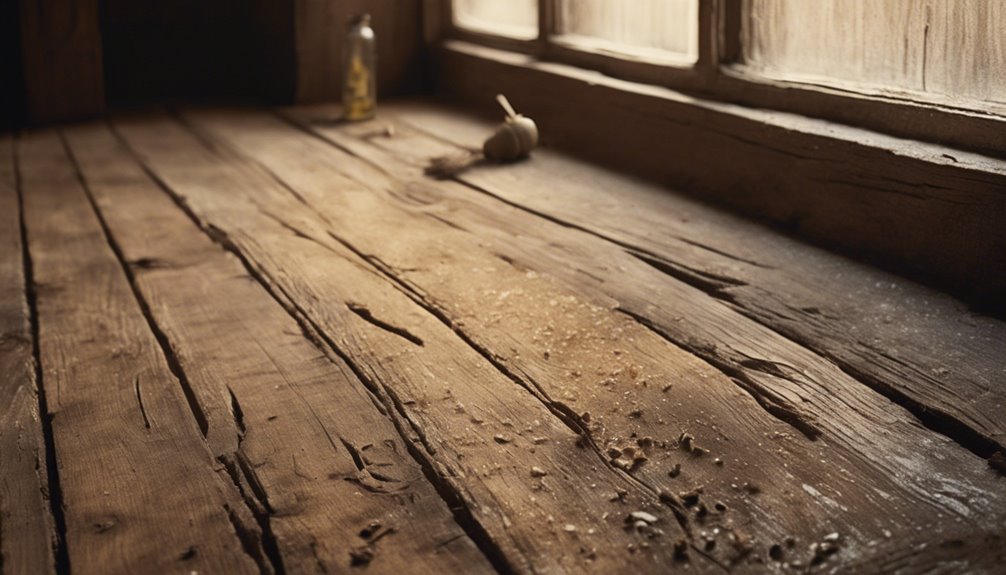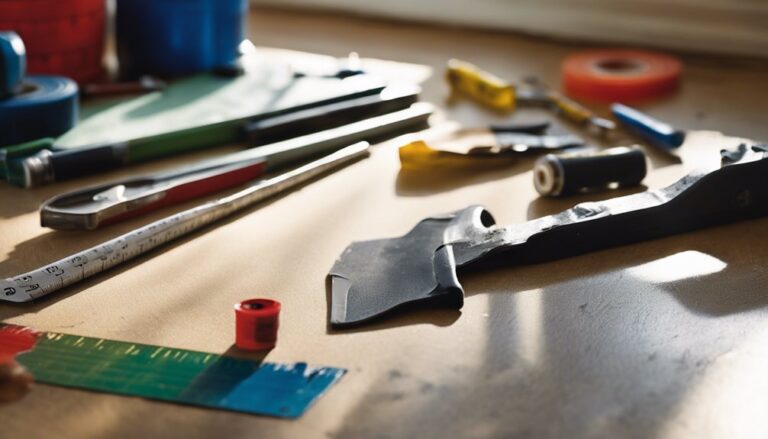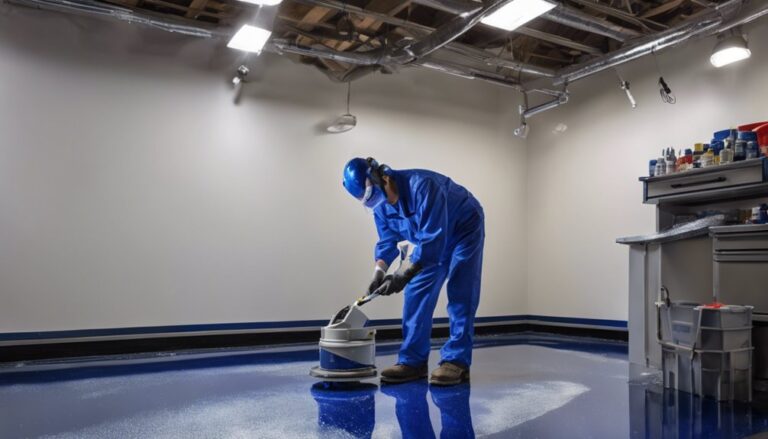To fix creaky wood floors, start by identifying the noise source, like loose boards or gaps from humidity changes. Tighten any loose floorboards by employing screws, ensuring they're countersunk for a cleaner look. Apply lubricants like paraffin oil or graphite powder between the boards for smoother movement. If certain areas need more support, insert shims snugly between the joists and boards. Finally, manage humidity and regularly check for loose boards to prevent future creaks. Want to banish those squeaks for good? There's plenty more you can do to keep your floors quiet and stable.
Identify the Cause
Before you can effectively fix those creaky wood floors, it's essential to identify the cause of the noise. Start by considering wood expansion, which often occurs due to changes in humidity and temperature. This can lead to gaps between the boards, allowing them to rub against each other or against nails. Next, examine the nail types used in your flooring. Older homes may have square-cut nails that can loosen over time, while modern floors often use spiral or ring-shank nails designed to grip better. By identifying whether the noise stems from expansion or loose nails, you'll be one step closer to reclaiming the peace and freedom of a quiet home. Take the time to pinpoint the issue, and your efforts will pay off.
Resserrer les lames de plancher desserrées
Once you've identified the cause of your creaky wood floors, it's time to tackle the issue by tightening loose floorboards. Start by locating the squeaky areas and gently lifting the affected boards. You'll want to use floorboard screws to secure them back in place. If there are gaps between the boards and joists, inserting screws at an angle can create a snug fit. This not only prevents movement but also enhances sound dampening, reducing those annoying creaks. Remember to countersink the screws slightly so they're less noticeable. After tightening, inspect the surrounding areas to verify everything feels solid. With these adjustments, you can enjoy a quieter, more stable sol, giving you the freedom to walk without worry.
Apply Lubrication Techniques
If your floorboards are still creaking after tightening them, applying lubrication techniques can help reduce noise and enhance comfort. Start by choosing oil types like paraffin or graphite powder, which work wonders on squeaky floors. You can use a syringe or a dropper for precise application, injecting the oil between the boards. Another effective method is to sprinkle graphite powder in the gaps and then walk around to work it in. This not only quiets the boards but also extends their life. Always test a small area first to verify compatibility with your flooring. With these simple steps, you can enjoy a quieter home and reclaim the freedom to move around without the annoying creaks.
Use Shims for Support
While creaky floors can be annoying, using shims for support is a practical solution that can greatly reduce noise. Shim installation is a straightforward process that enhances floor stability and minimizes movement. Here's how to get started:
- Identify the areas where the floor squeaks.
- Carefully lift the floorboards and insert shims snugly between the joists and the boards.
- Trim any excess shim material for a clean finish.
Replace Damaged Boards
Replacing damaged boards can be a game-changer for your creaky wood floors. If you've got warped or cracked boards, it's time to take action. Start by selecting the right replacement materials that match your existing flooring for a seamless look. You can find hardwood, laminate, or engineered wood options at your local home improvement store.
Once you've got your materials, it's essential to measure accurately. Remove the damaged boards carefully, making sure not to disrupt surrounding planks. Then, proceed with the board installation by securing the new boards with nails or adhesive, depending on your flooring type. Take your time to guarantee a snug fit; this'll help eliminate those pesky creaks and restore the beauty of your floors. Enjoy the freedom that comes with a smooth surface!
Prevent Future Creaks
To keep your wood floors quiet and creak-free, it's crucial to manage humidity levels in your home. Regular maintenance, like tightening loose boards and applying a protective finish, can also go a long way in preventing future issues. By staying proactive, you'll enjoy the beauty of your wood floors without the annoying sounds.
Humidity Control Measures
If you want to keep your wood floors in top shape and prevent future creaks, managing humidity levels in your home is essential. Fluctuating moisture levels can lead to wood expansion and contraction, causing those pesky sounds. Here are some effective humidity control measures:
- Use a dehumidifier to reduce excess moisture during humid months.
- Install a hygrometer to monitor indoor humidity levels and keep them between 30-50%.
- Ensure proper ventilation in areas prone to moisture, like bathrooms and kitchens.
Conseils d'entretien régulier
While maintaining your wood floors might seem like a chore, regular upkeep can greatly reduce the chances of creaking and extend their lifespan. Start with consistent cleaning routines to remove dust and debris that can cause wear. Use a soft broom or vacuum specifically designed for wood to avoid scratches. Incorporate a gentle wood floor cleaner into your floor care regimen every few months to nourish the wood and keep it looking fresh. Additionally, consider applying a protective finish every few years to enhance durability. Check for loose boards and secure them promptly. By committing to these simple tasks, you'll not only prevent future creaks but also enjoy the beauty and comfort of your wood floors for years to come.
Questions fréquemment posées
Can Creaky Wood Floors Indicate a Larger Structural Problem?
Could those annoying creaks in your floors signal something more serious? While creaky wood floors often stem from age or poor floor maintenance, they can sometimes hint at issues affecting your home's structural integrity. It's wise to investigate further, as ignoring them might lead to bigger problems down the line. Staying on top of your floor's condition not only keeps your space comfortable but also guarantees your home remains safe and sound.
How Often Should I Check My Floors for Creaks?
You should check your floors for creaks at least twice a year as part of your floor maintenance routine. Regular creak assessment helps catch minor issues before they escalate. Listen for changes in sound or feel when walking around; that way, you can maintain your home's charm and comfort. If you notice persistent creaks, don't hesitate to investigate further, ensuring you keep your living space safe and enjoyable for you and your family.
Will Humidity Affect the Creakiness of My Wood Floors?
You might think humidity doesn't play a big role in your wood floors, but it actually does. High humidity levels can cause the wood to swell, leading to increased creakiness. Moisture control is essential for maintaining the integrity of your floors. Conversely, low humidity can dry out the wood, making it shrink and also creak. Keeping an eye on humidity levels can help you enjoy a quieter, more comfortable living space.
Can Area Rugs Help Reduce the Noise From Creaky Floors?
Yes, area rugs can definitely help reduce the noise from creaky floors. By placing them strategically, you'll create a buffer that absorbs sound, making your living space quieter and more comfortable. Not only do they offer noise reduction, but they also add warmth and style to your home. So, if you're tired of those pesky creaks, consider investing in some area rugs to enhance both aesthetics and acoustics in your rooms.
Is It Safe to Walk on Creaky Floors While Repairing Them?
Walking on creaky floors can feel both freeing and risky. While you might want to embrace the freedom of movement, it's crucial to prioritize safety precautions. Before you step on those boards, conduct a thorough floor inspection to identify any loose or damaged areas. If you find issues, it's best to avoid walking on them until repairs are made. Balancing your desire for movement and the need for safety is key in this situation.




